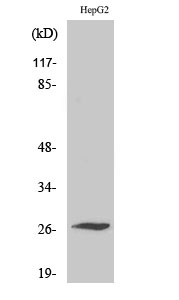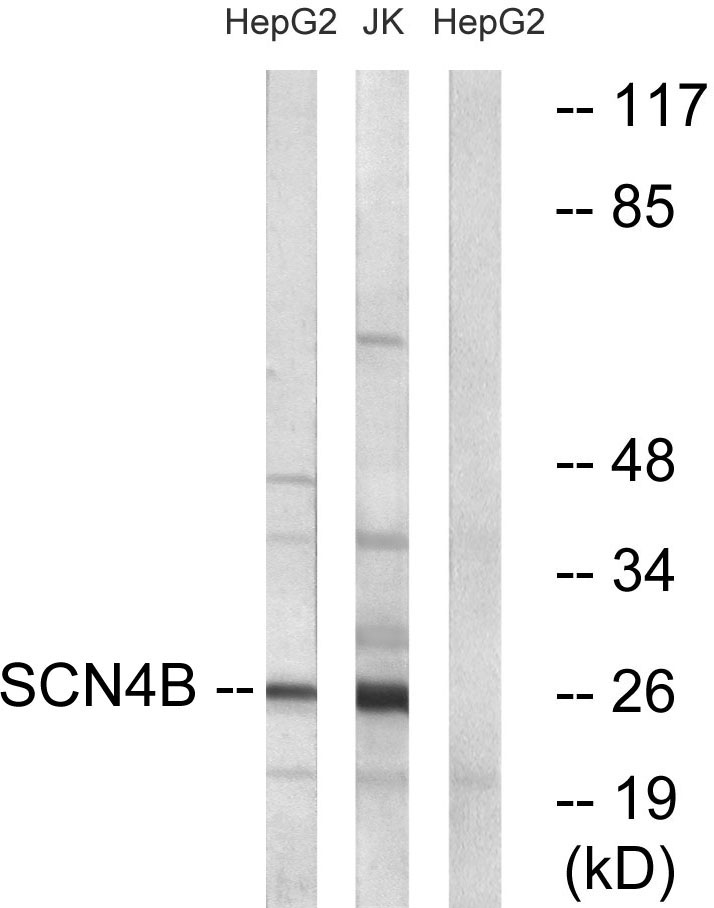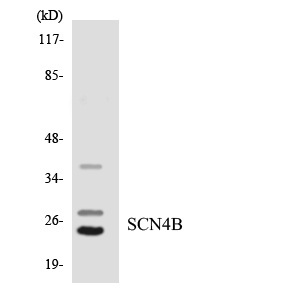Scn4b Polyclonal Antibody
- Catalog No.:YT4224
- Applications:WB;IHC;IF;ELISA
- Reactivity:Human;Rat;Mouse;
- Target:
- Scn4b
- Fields:
- >>Adrenergic signaling in cardiomyocytes
- Gene Name:
- SCN4B
- Protein Name:
- Sodium channel subunit beta-4
- Human Gene Id:
- 6330
- Human Swiss Prot No:
- Q8IWT1
- Mouse Swiss Prot No:
- Q7M729
- Immunogen:
- The antiserum was produced against synthesized peptide derived from human SCN4B. AA range:61-110
- Specificity:
- Scn4b Polyclonal Antibody detects endogenous levels of Scn4b protein.
- Formulation:
- Liquid in PBS containing 50% glycerol, 0.5% BSA and 0.02% sodium azide.
- Source:
- Polyclonal, Rabbit,IgG
- Dilution:
- WB 1:500 - 1:2000. IHC 1:100 - 1:300. ELISA: 1:10000.. IF 1:50-200
- Purification:
- The antibody was affinity-purified from rabbit antiserum by affinity-chromatography using epitope-specific immunogen.
- Concentration:
- 1 mg/ml
- Storage Stability:
- -15°C to -25°C/1 year(Do not lower than -25°C)
- Other Name:
- SCN4B;Sodium channel subunit beta-4
- Observed Band(KD):
- 27kD
- Background:
- The protein encoded by this gene is one of several sodium channel beta subunits. These subunits interact with voltage-gated alpha subunits to change sodium channel kinetics. The encoded transmembrane protein forms interchain disulfide bonds with SCN2A. Defects in this gene are a cause of long QT syndrome type 10 (LQT10). Three protein-coding and one non-coding transcript variant have been found for this gene.[provided by RefSeq, Mar 2009],
- Function:
- disease:Defects in SCN4B are the cause of long QT syndrome type 10 (LQT10) [MIM:611819]. Long QT syndromes are heart disorders characterized by a prolonged QT interval on the ECG and polymorphic ventricular arrhythmias. They cause syncope and sudden death in response to excercise or emotional stress. They can present with a sentinel event of sudden cardiac death in infancy.,function:Modulates channel gating kinetics. Causes negative shifts in the voltage dependence of activation of certain alpha sodium channels, but does not affect the voltage dependence of inactivation.,PTM:Contains a number of interchain disulfide bonds with SCN2A.,similarity:Contains 1 Ig-like C2-type (immunoglobulin-like) domain.,subunit:The voltage-sensitive sodium channel consists of an ion conducting pore forming alpha-subunit regulated by one or more beta-1, beta-2, beta-3 and/or beta-4 subunits. Beta-1 and beta-
- Subcellular Location:
- Cell membrane ; Single-pass type I membrane protein .
- Expression:
- Expressed at a high level in dorsal root ganglia, at a lower level in brain, spinal cord, skeletal muscle and heart. Expressed in the atrium.
- June 19-2018
- WESTERN IMMUNOBLOTTING PROTOCOL
- June 19-2018
- IMMUNOHISTOCHEMISTRY-PARAFFIN PROTOCOL
- June 19-2018
- IMMUNOFLUORESCENCE PROTOCOL
- September 08-2020
- FLOW-CYTOMEYRT-PROTOCOL
- May 20-2022
- Cell-Based ELISA│解您多样本WB检测之困扰
- July 13-2018
- CELL-BASED-ELISA-PROTOCOL-FOR-ACETYL-PROTEIN
- July 13-2018
- CELL-BASED-ELISA-PROTOCOL-FOR-PHOSPHO-PROTEIN
- July 13-2018
- Antibody-FAQs
- Products Images

- Western Blot analysis of various cells using Scn4b Polyclonal Antibody

- Western blot analysis of lysates from HepG2 and Jurkat cells, using SCN4B Antibody. The lane on the right is blocked with the synthesized peptide.

- Western blot analysis of the lysates from HeLa cells using SCN4B antibody.

- Immunohistochemical analysis of paraffin-embedded human tonsil. 1, Antibody was diluted at 1:200(4° overnight). 2, Tris-EDTA,pH9.0 was used for antigen retrieval. 3,Secondary antibody was diluted at 1:200(room temperature, 45min).



